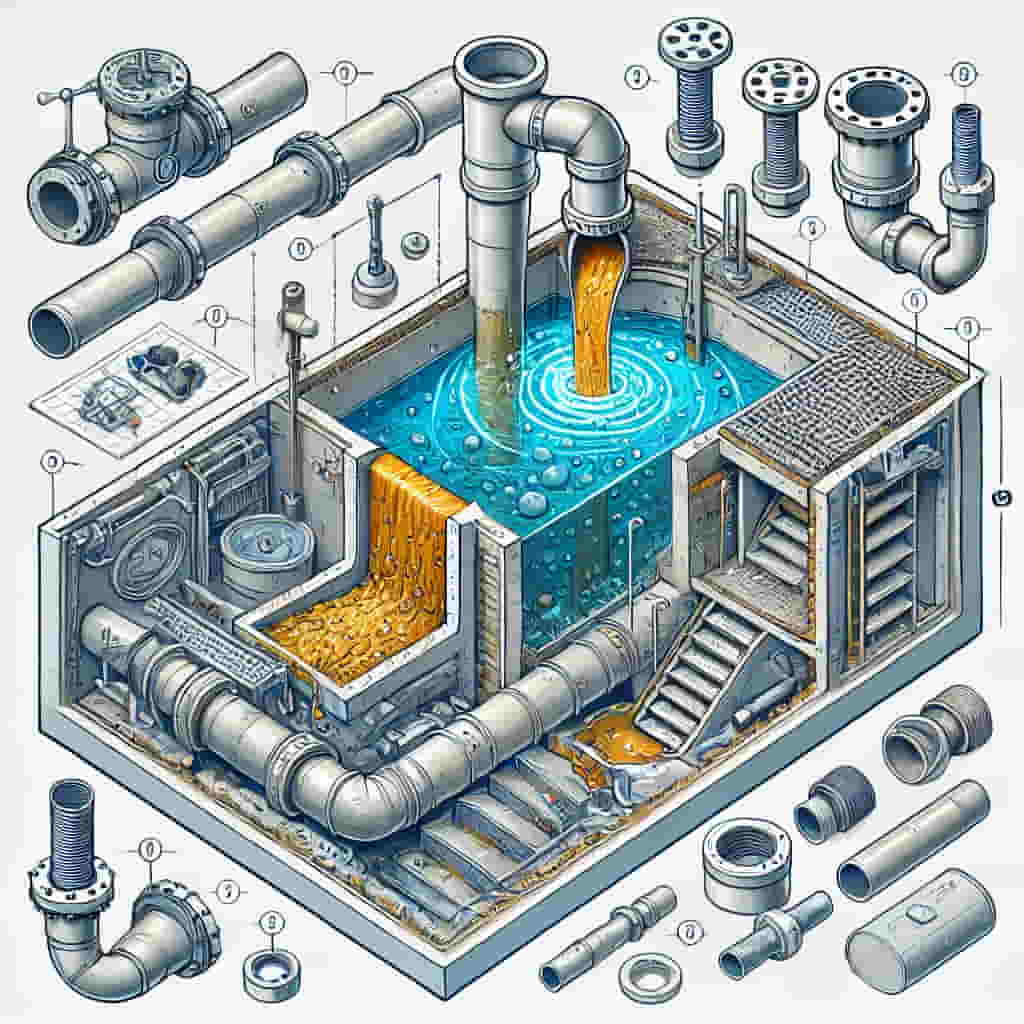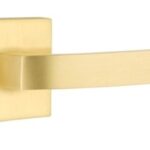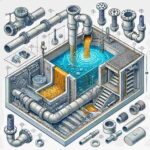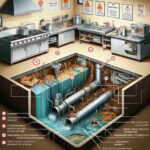Why is My Grease Trap Smelling? Common Issues and Preventative Measures

Running a restaurant is no small feat. You’re juggling food quality, customer service, staff management, and, let’s face it, a seemingly endless list of operational concerns. Among these, there’s one unsung hero (or villain, depending on the day) lurking in the back: the grease trap. If your grease trap is beginning to smell like something crawled in and died—well, it’s time to address the issue before it becomes a full-blown crisis. Let’s dive into why your grease trap might be smelling and how you can prevent it from turning your kitchen into a stinky mess.
The Not-So-Sweet Symphony of a Smelly Grease Trap
If you’ve noticed a less-than-appetizing odor wafting from your kitchen, it’s probably your grease trap sounding the alarm. A grease trap’s primary job is to intercept fats, oils, and grease (often referred to as FOG) before they enter the wastewater system. When functioning properly, it quietly collects grease, allowing water to flow through without any issues. But when it starts to smell, it’s like an unwelcome guest who overstays their welcome.
Why Does the Smell Happen?
The stench emanating from your grease trap is likely due to a combination of factors:
- Grease Buildup: Over time, the grease in your trap will accumulate. As it breaks down, it produces sulfuric compounds and fatty acids. These are the culprits behind that rotten egg smell that’s enough to make your eyes water.
- Improper Maintenance: Just like any other equipment in your restaurant, a grease trap requires regular grease trap cleaning. Skipping or delaying cleanings allows grease to build up and can lead to blockages. If left unchecked, it will not only smell but may also lead to more severe plumbing issues.
- Food Particles: Food waste that makes its way into the grease trap can start to decompose, adding another layer of odor. The combination of rotting food and grease is a recipe for a full-on olfactory assault.
- Standing Water: Water that lingers in your grease trap without proper drainage can stagnate and start to smell. This is particularly common if there’s a blockage preventing water from flowing through the system as it should.
- Incorrect Installation or Sizing: Grease traps that are not properly sized for the volume of wastewater your kitchen produces can lead to inefficient grease separation. Similarly, improper installation can cause water to bypass the grease trap, leading to quicker buildup and more frequent odor problems.
Preventing the Stench: The Power of Regular Grease Trap Cleaning
So, how do you keep your grease trap from turning your kitchen into a smelly nightmare? The answer is simple: regular grease trap cleaning.
Here’s why it’s essential:
- Prevent Clogs and Backups: A well-maintained grease trap is less likely to clog. This not only keeps your kitchen running smoothly but also prevents backups that could send foul-smelling water spewing from your drains.
- Avoid Fines and Compliance Issues: Local regulations often require regular grease trap cleaning. Failing to comply can lead to hefty fines and, in some cases, temporary closure of your restaurant. Be sure to check with local authorities regarding specific cleaning frequencies and requirements, as these can vary based on your location and the size of your restaurant.
- Extend the Life of Your Plumbing: Grease and other debris that make their way into your plumbing can cause significant damage over time. By keeping your grease trap clean, you’re protecting your pipes and avoiding costly repairs down the line.
- Protect Your Business’s Reputation: In the restaurant business, a clean environment is paramount. Bad odors are not just unpleasant—they can drive customers away and result in negative reviews. Regular grease trap maintenance helps ensure your restaurant maintains its reputation for cleanliness and professionalism.
- Environmental Responsibility: Regular grease trap maintenance also supports environmental responsibility. Properly maintained grease traps ensure that fats, oils, and grease don’t enter the wastewater system, where they can contribute to environmental pollution. This not only helps prevent sewer blockages but also protects local water sources from contamination.
How Often Should You Clean Your Grease Trap?
The frequency of grease trap cleaning can vary depending on the size of your trap, the volume of grease your kitchen produces, and local regulations. However, a general rule of thumb is to clean your grease trap every one to three months. Some high-volume restaurants may need to clean their traps more frequently, perhaps even monthly.
Local Regulations and Recommendations: It’s crucial to familiarize yourself with local regulations regarding grease trap cleaning. Some municipalities have specific guidelines on how often grease traps must be serviced, and failing to adhere to these can result in fines or other penalties. In some areas, you may be required to maintain records of your grease trap cleanings as proof of compliance.
Signs It’s Time for a Grease Trap Cleaning
Even with a regular schedule, sometimes you need to give your grease trap a little extra attention. Here are some signs that it’s time to call in the professionals for grease interceptor cleaning:
- Foul Odors: If your kitchen smells like a swamp, it’s a clear sign that your grease trap is overdue for a cleaning.
- Slow Draining Sinks: When your sinks are draining slowly, it could indicate a clog in your grease trap.
- Grease Buildup Around Drains: Visible grease around your drains or on the surface of the water in your sinks is a surefire sign that your grease trap is full.
- Grease Overflow: If grease is overflowing from the top of your grease trap, it’s not just time for cleaning—it’s an emergency!
- Increased Pest Activity: Unpleasant odors and food waste accumulation can attract pests like rodents and insects. If you notice an uptick in pest activity around your kitchen, it could be linked to an overdue grease trap.
The Process of Grease Trap Cleaning
Cleaning a grease trap is not a DIY project. It requires professional equipment and expertise. Here’s a quick rundown of what to expect when you hire grease management services:
- Inspection: A professional will start by inspecting your grease trap to assess the level of grease and identify any potential issues.
- Pumping: Using a vacuum truck, the professional will pump out all the grease, water, and debris from the trap.
- Scraping and Cleaning: After pumping, the interior of the grease trap is scraped and cleaned to remove any remaining grease and sludge.
- Inspection and Reassembly: Once cleaned, the grease trap is inspected for any signs of damage. If all is well, it’s reassembled, and freshwater is added to get it back in working order.
- Proper Disposal: The collected grease and waste are then disposed of following local environmental regulations. Some companies even recycle used grease for biofuel, so ask your service provider about their disposal practices.
- Reporting and Documentation: Many professional grease management services provide detailed reports after each cleaning. These reports can be invaluable for maintaining records of compliance with local regulations and for monitoring the effectiveness of your grease trap system over time.
Preventative Measures to Keep Your Grease Trap Fresh
While regular cleaning is critical, there are also several preventative measures you can take to minimize grease buildup and keep your grease trap smelling fresh:
- Scrape Plates Before Washing: Encourage your kitchen staff to scrape food scraps and grease into the trash before washing dishes. The less grease that enters your drains, the better.
- Use Strainers: Install strainers in your sinks to catch food particles before they enter the grease trap.
- Regular Maintenance Checks: Between professional cleanings, have your staff check the grease trap regularly. This can help catch any issues before they become major problems.
- Educate Your Team: Make sure your kitchen staff understands the importance of proper grease disposal and how to maintain the grease trap. A little education goes a long way in preventing issues.
- Install Grease Trap Additives: There are non-toxic, biodegradable additives available that can be introduced into the grease trap to help break down grease more efficiently. While not a replacement for regular cleaning, these additives can help reduce the frequency of professional cleanings by keeping the grease trap functioning more effectively between services.
- Consider Low-Fat Cooking Oils: Using low-fat cooking oils can reduce the amount of grease that ends up in your trap, minimizing buildup and extending the time between cleanings. This can also contribute to healthier menu options for your customers.
- Explore Grease Interceptor Installation: For larger establishments or those producing significant amounts of grease, installing a grease interceptor may be a worthwhile investment. These larger units provide additional capacity for separating grease from wastewater and can be more effective in reducing the frequency of maintenance.
Closing Thoughts
Don’t let a stinky grease trap tarnish your restaurant’s reputation. Regular grease trap cleaning and maintenance are key to keeping odors at bay and ensuring your kitchen runs smoothly. Whether you’ve noticed a smell, slow drains, or just want to be proactive, now’s the time to get your grease trap in top shape. Call in the professionals, educate your staff, and take control of your kitchen’s grease management.
When it comes to grease trap cleaning, an ounce of prevention is worth a pound of cure. Keep that grease trap clean, and your kitchen will thank you. After all, your focus should be on creating delicious dishes, not dealing with greasy odors and clogged pipes.







